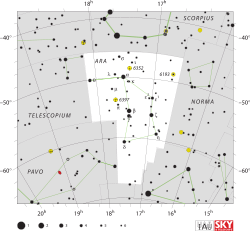Gamma Arae

| |
| Observation data Epoch J2000 Equinox J2000 | |
|---|---|
| Constellation | Ara |
| Right ascension | 17h 25m 23.65931s[1] |
| Declination | –56° 22′ 39.8148″[1] |
| Apparent magnitude (V) | 3.34[2] |
| Characteristics | |
| Spectral type | B1 Ib[3] |
| U−B color index | –0.96[2] |
| B−V color index | –0.13[2] |
| Astrometry | |
| Radial velocity (Rv) | –3[4] km/s |
| Proper motion (μ) | RA: –0.44[1] mas/yr Dec.: –15.77[1] mas/yr |
| Parallax (π) | 2.93 ± 0.16[1] mas |
| Distance | 1,110 ± 60 ly (340 ± 20 pc) |
| Absolute magnitude (MV) | –5.8[5] |
| Details | |
| Mass | 12.5[6]–25[5] M☉ |
| Radius | 23[7] R☉ |
| Luminosity | 120,000[5] L☉ |
| Surface gravity (log g) | 2.90[8] cgs |
| Temperature | 21,500[8] K |
| Rotation | 4.8[9] |
| Rotational velocity (v sin i) | 269 ± 11[8] km/s |
| Age | 15.7 ± 0.1[6] Myr |
| Other designations | |
| Database references | |
| SIMBAD | data |
| Database references | |
| SIMBAD | data |
| Data sources: | |
| Hipparcos Catalogue, CCDM (2002), Bright Star Catalogue (5th rev. ed.) | |
Gamma Arae (γ Ara, γ Arae) is a star in the southern constellation of Ara. With an apparent visual magnitude of 3.3,[2] it is the fourth-brightest star in the constellation and is readily visible to the naked eye. From parallax measurements made during the Hipparcos mission, the distance to this star can be estimated as 1,110 light-years (340 parsecs) from Earth.
This is an enormous star with 23[7] times the radius of the Sun. It is radiating 120,000[5] as much energy as the Sun from its outer envelope at an effective temperature of 21,500 K.[8] This heat gives the star the blue-white glow of a B-type star. The spectrum shows it to match a stellar classification of B1 Ib,[3] with the luminosity class of 'Ib' indicating this is a lower luminosity supergiant star.[10] It is a relatively young body, with an estimated age of around 15.7 million years.[6]
Gamma Arae is rotating rapidly with a projected rotational velocity of 269 km s−1, causing it to complete a full rotation about every 4.8 days.[9] In the spectrum of this star, this high rate of spin is causing absorption lines to blend together because of the Doppler effect, making them more difficult to analyze.[5] It is a periodically variable star that undergoes non-radial pulsations with a primary period of 1.1811 days and a secondary period of 0.1281 days.[8]
There is some disagreement about the mass of this star in the literature. Tetzlaff et al. (2011) estimate the mass as 12.5 ± 0.6[6] solar masses, while Fraser et al. (2010) give a mass of around 19[8] and Lefever et al. (2007) lists a value of 25.[5] It is shedding mass through its stellar wind at the rate of 3.0 × 10−8 solar masses per year, which is equivalent to losing the mass of the Sun every 33 million years.[8] The wind is being effected by the star's rapid rotation, resulting in an enhanced outflow along the equator.[7]
Gamma Arae has an optical companion located at an angular separation of 17.9 arcseconds, which is an A-type main sequence star with an apparent magnitude of 10.5.
References
- 1 2 3 4 5 van Leeuwen, F. (November 2007), "Validation of the new Hipparcos reduction", Astronomy and Astrophysics, 474 (2): 653–664, arXiv:0708.1752
 , Bibcode:2007A&A...474..653V, doi:10.1051/0004-6361:20078357
, Bibcode:2007A&A...474..653V, doi:10.1051/0004-6361:20078357 - 1 2 3 4 Nicolet, B. (1978). "Photoelectric photometric Catalogue of homogeneous measurements in the UBV System". Astronomy and Astrophysics Supplement Series. 34: 1–49. Bibcode:1978A&AS...34....1N.
- 1 2 Prinja, R. K.; Massa, D. L. (October 2010), "Signature of wide-spread clumping in B supergiant winds", Astronomy and Astrophysics, 521: L55, arXiv:1007.2744
 , Bibcode:2010A&A...521L..55P, doi:10.1051/0004-6361/201015252
, Bibcode:2010A&A...521L..55P, doi:10.1051/0004-6361/201015252 - ↑ Evans, D. S. (June 20–24, 1966), Batten, Alan Henry; Heard, John Frederick, eds., The Revision of the General Catalogue of Radial Velocities, University of Toronto: International Astronomical Union, Bibcode:1967IAUS...30...57E
- 1 2 3 4 5 6 Lefever, K.; Puls, J.; Aerts, C. (March 2007), "Statistical properties of a sample of periodically variable B-type supergiants. Evidence for opacity-driven gravity-mode oscillations", Astronomy and Astrophysics, 463 (3): 1093–1109, arXiv:astro-ph/0611484
 , Bibcode:2007A&A...463.1093L, doi:10.1051/0004-6361:20066038
, Bibcode:2007A&A...463.1093L, doi:10.1051/0004-6361:20066038 - 1 2 3 4 Tetzlaff, N.; Neuhäuser, R.; Hohle, M. M. (January 2011), "A catalogue of young runaway Hipparcos stars within 3 kpc from the Sun", Monthly Notices of the Royal Astronomical Society, 410 (1): 190–200, arXiv:1007.4883
 , Bibcode:2011MNRAS.410..190T, doi:10.1111/j.1365-2966.2010.17434.x
, Bibcode:2011MNRAS.410..190T, doi:10.1111/j.1365-2966.2010.17434.x - 1 2 3 Prinja, R. K.; et al. (February 1997), "Wind variability of B supergiants. II. The two-component stellar wind of γ Arae", Astronomy and Astrophysics, 318: 157–170, Bibcode:1997A&A...318..157P
- 1 2 3 4 5 6 7 Fraser, M.; Dufton, P. L.; Hunter, I.; Ryans, R. S. I. (May 2010), "Atmospheric parameters and rotational velocities for a sample of Galactic B-type supergiants", Monthly Notices of the Royal Astronomical Society, 404 (3): 1306–1320, arXiv:1001.3337
 , Bibcode:2010MNRAS.404.1306F, doi:10.1111/j.1365-2966.2010.16392.x
, Bibcode:2010MNRAS.404.1306F, doi:10.1111/j.1365-2966.2010.16392.x - 1 2 Prinja, R. K.; Massa, D.; Fullerton, A. W. (June 2002), "Wind variability of B supergiants. IV. A survey of IUE time-series data of 11 B0 to B3 stars", Astronomy and Astrophysics, 388: 587–608, Bibcode:2002A&A...388..587P, doi:10.1051/0004-6361:20020503
- ↑ "The Colour of Stars", Australia Telescope, Outreach and Education, Commonwealth Scientific and Industrial Research Organisation, December 21, 2004, retrieved 2012-01-16